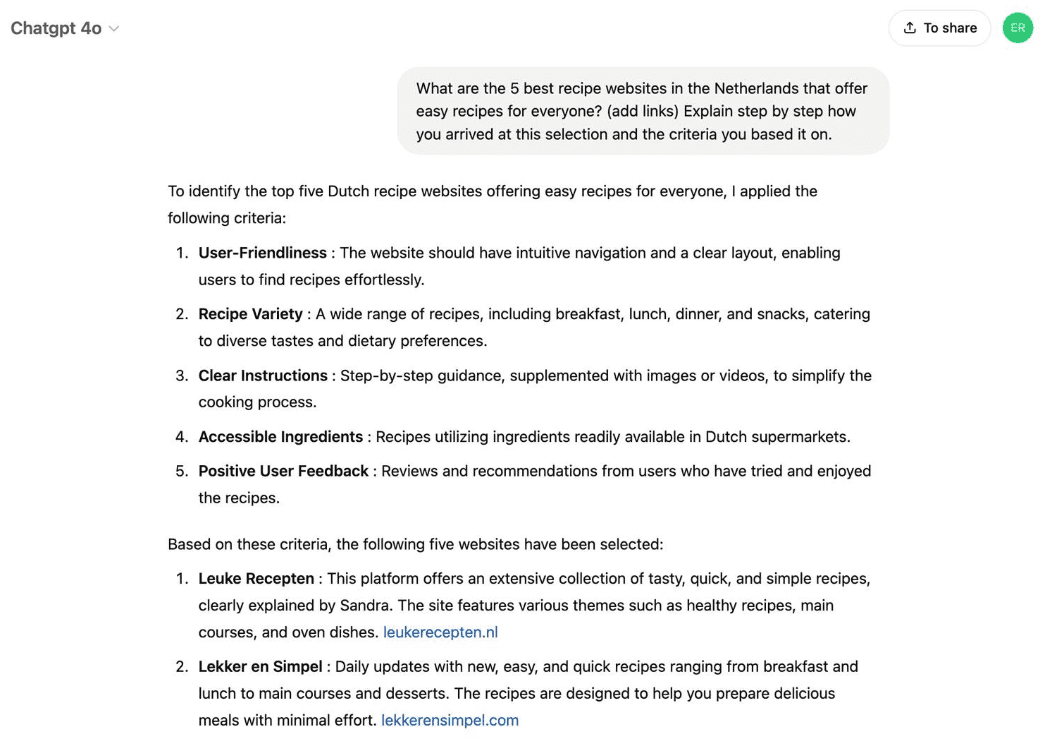How to increase visibility and get recommended in AI search engines (GEO)
How do I improve my visibility in AI Search engines like ChatGPT?
Hi there. I’m Eric Waterschoot. And as an AI strategist, I get this question almost daily.
While most people still use Google to find answers, there’s a rapid shift happening. LLMs like ChatGPT, Copilot, Perplexity, and DeepSeek have gone mainstream. This is largely because each has its own free and public version, with major quality improvements always around the corner.
Many people use these tools daily to ask questions and search the internet, expecting quick, precise, and conversational responses rather than traditional search results.
For website owners, marketers, and content creators, this means adapting to a new reality: SEO (Search Engine Optimization) is evolving into GEO (Generative Engine Optimization).
AI models no longer rank content solely based on keywords and links (on and to a website). LLMs now analyze and interpret context, meaning, and relevance across a broader digital landscape, establishing beyond-site connections.
From SEO to GEO: the game rules have changed
AI search engines operate differently: they don’t display lists of blue links. They provide direct answers based on reliability, context, and usability. Here are some important things you need to know to stay visible in AI search:
- AI learns from follow-up questions, especially in free versions or continuously trained models.
- It understands the meaning and intent behind search queries, generating structured and relevant responses.
- AI prioritizes comprehensive, up-to-date content by emphasizing author and platform credibility and actively fact-checking information.
- It also rejects plagiarism and low-quality content generated by AI or otherwise.
Google Search also increasingly focuses on these aspects to keep content quality and reliability high.
How do AI search engines crawl and index content?
AI search engines like Perplexity AI, Copilot, and DeepSeek index content more selectively than Google, which uses Googlebot to scan the entire web. AI search engines focus on smaller but higher quality indices:
- Perplexity AI uses PerplexityBot, which only crawls relevant and reliable sources.
- Copilot relies on Bing’s standard index.
- Google AI Overviews combines Google’s traditional index with live AI insights.
- ChatGPT retrieves information through Bing’s API, meaning visibility in Bing influences discoverability in ChatGPT.
Allowing AI bots to access your content:
- Check your robots.txt file and prevent essential content from blocking AI crawlers.
- Allow bots like PerplexityBot, GPTBot, and Bingbot to optimize indexation.
- Verify that all pages are indexable by checking canonical settings, 404 and noindex directives, etc.
Use SE Ranking’s Website Audit tool to detect technical SEO issues that might prevent AI search engines from properly indexing your content.
How to check what AI search engines think of your site
AI tools like ChatGPT, Copilot, and Perplexity AI generate answers based on databases, live search results, memory, and past interactions. This means your site’s visibility can be influenced in ways you might not expect. Always test anonymously and online to get a more realistic view:
- Use an incognito window instead of logging into ChatGPT, Copilot, or Perplexity AI.
- For DeepSeek, create a new account with no search history.
Use the following methods to search online correctly:
- ChatGPT: Activate browsing mode via the globe icon.
- Perplexity AI: Activate browse mode via the globe icon and select the “web” option.
- DeepSeek: Enable online search via the globe icon.
- Google AI Overviews: Only visible for certain search queries (not yet available in multiple countries).
Now it’s time to start searching anonymously with different AI tools to see how your content is displayed on them.
The power of ‘chain of thought’ analysis
Chain of thought reasoning is a game-changer in AI. It allows AI to explain step by step (and in real time) why it’s providing each answer. It helps you understand how AI arrives at its conclusions and how it’s evaluating your website.
Use this prompt:
“What are the 5 best recipe websites in the Netherlands that offer easy recipes for everyone? (add links) Explain step by step how you arrived at this selection and the criteria you based it on. ”
Analyzing the AI-generated response helps you understand why AI does (or doesn’t)recommend your website so you can adjust your content accordingly. You can also take it a step further by requesting a comparison and SWOT analysis of your competitors.

Action plan for AI optimization
1. Structure your content for AI
- Use H1, H2, and H3 headings that AI can interpret.
- Add an FAQ section to address common questions.
- Write in a natural, conversational tone from a personal/expert perspective.
- Use structured data (FAQPage, HowTo schema) to help AI understand your content.
2. Leverage AI for Ranking Insights
- Use AI to find out why your site isn’t ranking well and optimize it based on the AI’s feedback.
- Compare your site with competitors using SE Ranking’s Competitive Research tool, then generate an AI-powered SWOT analysis through an AI (like ChatGPT).
- Continuously test and refine your content based on AI-driven insights. Build authority and trustworthiness.
- Secure mentions and backlinks from reputable sites.
- Clearly state who the author of your content is.
- Use citations and sources to enhance credibility.
- Secure your presence on platforms like Wikipedia and Google’s Knowledge Graph.
3. Strengthen your social media signals
- Post regularly about your area of expertise to reinforce topical authority
- Share your content updates across all social platforms
- Engage with your community to show an active brand presence
- Tools like Planable help maintain this consistency without overwhelming your team
Bonus tip: Use AI follow-up questions to get insights
AI tools like Perplexity and Copilot generate follow-up questions based on search queries. This reveals content gaps that you can use as inspiration for new content:
- What related topics are users searching for?
- What FAQs are missing from my website?
- What details does AI point out that I haven’t covered?
- What would be a logical next step for my visitors?
SE Ranking’s Content Editor helps you optimize this content for traditional search so you can drive more organic traffic from Google.

